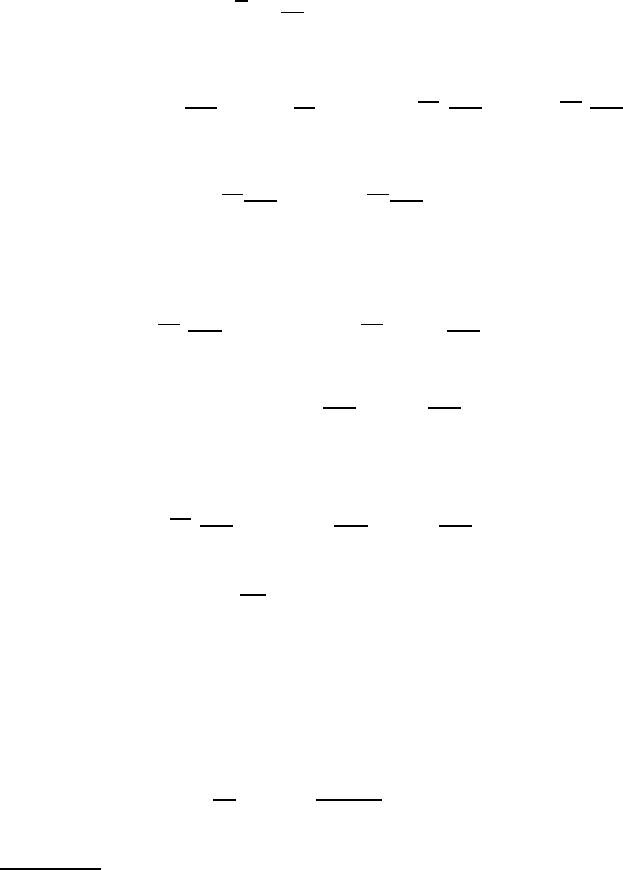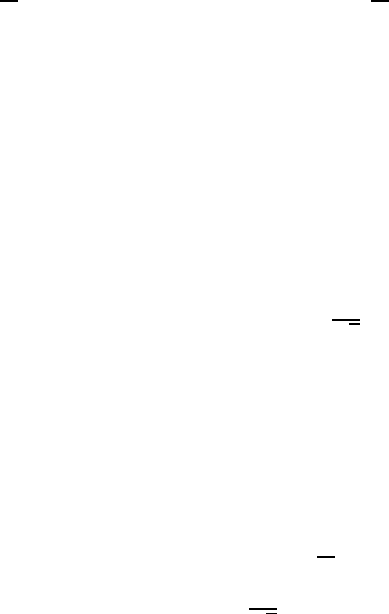Galdi G.P. An Introduction to the Mathematical Theory of the Navier-Stokes Equations: Steady-State Problems
Подождите немного. Документ загружается.

676 X Three-Dimensional Flow in Exterior Domains. Irrotational Case
we recover
(v · ∇v, w
k
) = −(v · ∇w
k
, v) (X.3.30)
for a ll k ∈ N. Using (X.3.17) and Theorem II.6.1 it follows that
|(v · ∇v, w
k
−w)| ≤ M|v|
1,2
k(w
k
− w)/|x|k
2
≤ c|v|
1,2
|w
k
−w|
1,2
(X.3.31)
while Lemma X.2.1 furnishes
|(v · ∇(w
k
−w), v)| ≤ kvk
2
4
|w
k
−w|
1,2
. (X.3.32)
Recalling (X.3.26), we pass to the limit k → ∞ in (X.3.30) and use (X.3.31),
(X.3.32) to show the validity of (i). The proof of (ii) is analogous, and therefore
it will be omitted. In view o f (i ) and (ii ) from (X.3.29) we have
R
−1
|u|
2
1,2
≤ −(v · ∇w, v) + (w · ∇w, v) + (v · ∇v, v) − (w · ∇v, v)
= (u · ∇u, v).
(X.3.33)
However, by assumption and (II.6.10),
|(u · ∇u, v)| ≤ M ku/|x|k
2
|u|
1,2
≤ 2M |u|
2
1,2
which, once replaced into (X.3.33), furnishes
|u|
1,2
(R
−1
− 2M) ≤ 0.
By (X.3.18) this inequali ty implies u(x) = 0 for a.a. x ∈ Ω, and the theorem
is proved. ut
Remark X.3.3 Theorem X.3.2 continues to hold in any dimension n ≥ 4,
provided we replace the bound on M given in (X.3.18) with a suitable one
depending on n. This generalization has been considered by Miyakawa (1995).
X.4 Existence of Generalize d Solutions
As in the case of a bounded domain, the fundamental contribution to the
existence of steady-state solutions to the Navier–Stokes problem in exterior
domains is due to J.Leray (1933, Chapitre III). Again, the leading idea is to
employ the following a prio ri estimate for solutions to (X.0.3), (X.0.4) with
v
∗
= 0:
Z
Ω
∇v : ∇v ≤ M (X.4 .1)
where M depends only on f, Ω and ν. Actually, for a ny R > δ(Ω
c
), Leray
looked for a solution to (X.0.3), (X.0.4) in Ω
R
with v
∗
= 0 at ∂Ω and v = v
∞

X.4 Existence of Generalized Solutions 677
at ∂B
R
and he was able to prove the existence of a solution v
R
, p
R
such that
the Dirichlet integral admits a unifo rm bound
Z
Ω
R
∇v
R
: ∇v
R
≤ M (X.4.2)
with M independent of R. Upon taking a suitable sequence, as R → ∞, a
solution v, p to (X.0.3), (X.0.4) was found. Because of (X.4.2), this solution
satisfies (X.4.1). In the case of three–dimensional flow, the estimate (X.4.1)
is enough to ensure all requirements of a generalized solution, including the
behavior at infinity. This latter property is in fact a consequence of Lemm a
II.6.2. However, for plane flow the bound (X.4.1) is not enough to control
the behavior at infinity of the solution. It is this circumstance that renders
the problem of existence of solutio ns in a two-dimensional exterior problem a
very difficult one and, in several respects, it has to b e considered still an open
question; cf. Chapter XII.
The method we shall employ to show existence is, in fact, different from
Leray’s and it is the same used for the case of a bounded domain, namely,
the Galerkin method. Such an approach is due to Fujita (1961). The proofs
given in Theorem IX.3.1 and Theorem IX.4.1 remain essentially unchanged to
cover the present case (cf. Remark I X.3.2). The only point that deserves some
attention is the construction of a suitable extension V of the velocity field at
the boundary and at infinity. Actually, as in the case where Ω is bounded,
we have to require that V satisfies an inequality of the type (IX.4.3) for
all u ∈ D
1,2
0
(Ω) and some α < ν. The first part of this section is devoted
to the preceding question. In this regard, we observe that, for such a field
V to exist, the vanishing of the overall flux Φ of the velocity field through
the bounding walls is not needed; rather, it is enough that Φ be “sufficiently
small” in a way that will be made precise later. However, it is not known
whether an upper bound for Φ is in fact necessary and consequently, unlike
the corresponding linearized Stokes and Oseen approximations, the problem
of existence of steady Navier–Stokes flow in exterior domains with arbitrary
flux at the boundary remains open.
With a view to the rotational case, that will be treated in the following
chapter, we shall construct the extension field V under more general assump-
tions on v
∞
than needed here.
To begin with, we need to introduce certain quantities. We recall that
Ω = R
3
− ∪
s
i=1
Ω
i
, s ≥ 1, where each Ω
i
is compact and, we assume, with a
non-empty interior. Furthermore, Ω
i
∩ Ω
j
= ∅, for i 6= j. We thus set
σ
i
(x) =
1
4π
∇
1
|x − x
i
|
, x
i
∈
◦
Ω
i
, i = 1, . . . , s, (X.4.3 )
and observe that
Z
∂Ω
i
σ
j
· n = δ
ij
, i, j = 1, . . . , s , (X.4.4)
where n denotes the outer normal to ∂Ω at ∂Ω
i
.

678 X Three-Dimensional Flow in Exterior Domains. Irrotational Case
Lemma X.4.1 Let Ω be a locally Lipschitz domain of R
3
exterior to s ≥ 1
compact and disjoint sets Ω
1
, ..., Ω
s
, and let
v
∗
∈ W
1/2,2
(∂Ω), v
∞
:= a + A · x ,
where a ∈ R
3
and A is a second order tensor with trace ( A) = 0. Then, for
any η > 0, there exists ε = ε(η, v
∗
, Ω) > 0 and V = V (ε) : Ω → R
3
such
that, for some R > δ(Ω
c
) and all q ∈ (1, ∞), r ∈ (3/2, ∞):
(i) V + v
∞
∈ W
1,2
(Ω
R
) ∩D
1,q
(Ω
R
);
(ii) V + v
∞
∈ L
r
(Ω
R
);
(iii) V = v
∗
at ∂Ω;
(iv) ∇ · V = 0 in Ω.
Furthermore, for all u ∈ D
1,2
0
(Ω), it holds that
|(u · ∇(V + v
∞
), u)| ≤
η +
1
4π
s
X
i=1
|Φ
i
|max
x∈Ω
1
|x − x
i
|
|u|
2
1,2
. (X.4.5)
where
Φ
i
=
Z
∂Ω
i
v
∗
· n, i = 1, . . . , s,
is the flux of v
∗
through the boundary of Ω
i
. Finally, if kv
∗
k
1/2,2(∂Ω)
≤ M,
for som e M > 0, then
kV + v
∞
k
1,2
≤ C
1
kv
∗
k
1/2,2(∂Ω)
kV + v
∞
k
r,Ω
R + |V + v
∞
|
1,q,Ω
R ≤ C
2
kv
∗
k
1/2,2,(∂Ω)
,
(X.4.6)
where C
1
= C
1
(η, M, Ω), and C
2
= C
2
(r, q, R, Ω).
Proof. The procedure is simila r to, but si mpler than, that used in the proof
of Lemma IX.4. 2. We set
v
1
(x) = v
∗
(x) −
s
X
i=1
Φ
i
σ
i
(x) + v
∞
, x ∈ ∂Ω .
Clearly, because of (X.4.4),
Z
∂Ω
i
v
1
· n = 0, i = 1, . . ., s,
and so, according to Lemm a IX.4. 1, there is w ∈ W
2,2
(Ω) such that, setting
U := ∇ × w ∈ W
1,2
(Ω)
we have

X.4 Existence of Generalized Solutions 679
U = v
1
at ∂Ω
U(x) = 0, for all x ∈ Ω
R
, R > δ(Ω
c
).
Given ε > 0, we set
V
ε
= ∇ ×(ψ
ε
w)
with ψ
ε
the “cut-off” f unction defined in Lemma II I.6.2. The desired extension
of v
∗
is then given by
V = V
ε
+
s
X
i=1
Φ
i
σ
i
−v
∞
≡ V
ε
+ V
σ
− v
∞
. (X.4.7 )
Taking into account the properties of the function w given in Lemma IX.4.1,
with the help of (X.4 .3) it i s immediate to show that V satisfies (i)-(iv). Let
us now estimate the trilinear form
a(u, V + v
∞
, u) ≡ (u ·∇(V + v
∞
), u) = a(u, V
ε
+ V
σ
, u), u ∈ D
1,2
0
(Ω).
Fix η > 0. By reasoning entirely anal ogous to that used in the proof of Lemma
IX.4. 2, and which we shall leave to the reader, we have
|a(u, V
ε
, u)| ≤ η |u|
2
1,2
, (X.4.8)
provided ε ≤ η/
c
4
kv
∗
k
1/2,2(∂Ω)
, for suitable c
4
= c
4
(Ω). Furthermore,
integrating by parts and recalling (X.4.3), we find
|a(u, V
σ
, u)| ≤
s
X
i=1
|Φ
i
|
Z
Ω
|∇u|
2
|E(x − x
i
)| ≤
1
4π
s
X
i=1
|Φ
i
|max
x∈Ω
1
|x − x
i
|
|u|
2
1,2
(X.4.9)
Inequality (X.4.5) then follows from (X.4. 8) and (X.4.9). It remains to show
(X.4.6), under the further stated assumptions on v
∗
. By the same argument
used in the proof of Lemma IX.4.1 (specifically, the argument leading to
(IX.4.48)), we easily infer
kV
ε
k
1,2
≤ c
1
kv
∗
k
1/2,2(∂Ω)
(X.4.10)
with c
1
= c
1
(η, M, Ω). Mo reover, from (X.4.3) we deduce
|V
σ
|
1,q
+ kV
σ
k
r
≤ c
1
kv
∗
k
1/2,2(∂Ω)
, for all q ∈ (1, ∞), r ∈ (3/2, ∞),
(X.4.11)
where c
2
= c
2
(Ω). Then, noticing that V (x) + v
∞
= V
σ
for all |x| ≥ R, Ω
R
containing the support of ψ
ε
,
1
we conclude that (X.4.6) follows from (X.4.10)
and (X.4 .11). ut
1
Notice that ∪
ε>0
supp (ψ
ε
) is bounded.

680 X Three-Dimensional Flow in Exterior Domains. Irrotational Case
Remark X.4.1 If s = 1, choosing x
1
= 0, we have
max
x∈Ω
1
|x|
≤
1
r
0
, r
0
= dist (0, ∂Ω),
condition (X.4.5) becomes
|(u · ∇(V + v
∞
), u)| ≤
η +
|Φ
1
|
4πr
0
|u|
2
1,2
.
Remark X.4.2 We would like to discuss the generali zation of Lemma X.4.1
to arbitrary di mension n ≥ 2, n 6= 3, in the case v
∞
≡ v
∞
∈ R
n
. If n ≥ 4, the
generalization is straightforward, provided we require a little more regularity
on v
∗
of the type
v
∗
∈ W
1−1/s,s
(∂Ω), s > n/2.
The extra regularity is needed to construct the extension field V
ε
, cf. Remark
IX.4. 7. If we assume this, we can prove the existence of a field V satisfying
(i)-(iv) for all q ∈ (1, ∞) and all r ∈ (n/(n−1), ∞ ). Furthermore, the following
inequality holds
|(u ·∇V , u)| ≤ (η + Φ
(n)
)|u|
2
1,2
where
Φ
(n)
≡ c
s
X
i=1
|Φ
i
| max
x∈Ω
1
|x −x
i
|
n−2
and c = c(n). In the two-dimensional case, the starting point is, again, (X.4.7),
with
σ
i
(x) =
1
2π
∇(log |x − x
i
|) . (X.4.12)
By following exactly the same arguments used for the proof of Lemma X.4.1,
we thus show that V satisfies (i)-(iv) with q ∈ (1, ∞) and r ∈ (2, ∞), as
well as the inequalities in (X.4.6), under the stated further assumption on v
∗
.
Moreover, we have
|(u · ∇V , u)| ≤ (η +
1
2π
s
X
i=1
|Φ
i
|)|u|
2
1,2
.
Given the properties of V
ε
, the proof of this latter is, as in Lemma X.4. 1,
reduced to show the estimate
|(u · ∇V
σ
, u)| ≤
1
2π
s
X
i=1
|Φ
i
||u|
2
1,2
. (X.4.13)
However, (X.4.13) can not be obtained by a procedure similar to that used
to obtain (X.4.9), and we have to argue differently. The following argument

X.4 Existence of Generalized Solutions 681
is due to A. Russo (2010b, Lemma 3). By integration by parts, the proof of
(X.4.13) reduces to show (i = 1, . . ., s)
I
i
:= 2π
Z
Ω
u · ∇u · σ
i
≤ |u|
2
1,2
. (X.4.14)
We introduce a system of po lar coordinates (r, θ) with the origin at x
i
, and
set
f :=
1
2π
Z
2π
0
f(r, θ)dθ .
Extending u to 0 in Ω
c
, we find
I
i
= 2π
Z
Ω
u · ∇u ·
x
|x|
2
=
Z
∞
0
dr
r
Z
2π
0
(u
1
−u
1
)
∂u
2
∂θ
−(u
2
− u
2
)
∂u
1
∂θ
dθ
,
(X.4.15)
where we used
Z
2π
0
u
1
∂u
2
∂θ
dθ =
Z
2π
0
u
2
∂u
1
∂θ
dθ = 0 .
Employing the Schwarz inequality, along with the Wirtinger inequality (I I .5.17)
and Exercise II.5.1 2, we deduce
Z
2π
0
(u
1
− u
1
)
∂u
2
∂θ
≤
Z
2π
0
|u
1
−u
1
|
2
Z
2π
0
∂u
2
∂θ
2
!
1/2
≤
Z
2π
0
∂u
1
∂θ
2
Z
2π
0
∂u
2
∂θ
2
!
1/2
,
(X.4.16)
and, likewise,
Z
2π
0
(u
2
− u
2
)
∂u
1
∂θ
≤
Z
2π
0
∂u
2
∂θ
2
Z
2π
0
∂u
1
∂θ
2
!
1/2
(X.4.17)
Therefore, o bserving that |
∂u
∂θ
| ≤ r|∇u|, we find that (X.4.14) follows from
(X.4.15)–(X.4.17).
Theorem X.4.1 Let Ω be a locally Lipschitz do mai n of R
3
, exterior to com-
pact and disjoint domains Ω
1
, ..., Ω
s
, s ≥ 1.
2
Moreover, let
f ∈ D
−1,2
0
(Ω), v
∗
∈ W
1/2
(∂Ω), v
∞
∈ R
3
,
and set
Φ :=
1
4π
s
X
i=1
max
x∈Ω
1
|x − x
i
|
Z
∂Ω
i
v
∗
· n
.
The following prop erties hold.
2
The theorem continues to hold in the case where Ω = R
3
.

682 X Three-Dimensional Flow in Exterior Domains. Irrotational Case
(i) Existence. If Φ < 1/R, there exists at l east one generalized solution v to
the Navier–Stokes problem (X.0.8), (X.0.4). Such a solution verifies the
conditions:
Z
S
2
|v(x) + v
∞
| = O(1/
p
|x|) as |x| → ∞
kpk
2,Ω
R
/R
≤ c (|v|
1,2
+ Rkvk
2
1,2Ω
R
+ R|f|
1,2
)
(X.4.18)
for all R > δ(Ω
c
). In (X.4.18) p is the pressure field associated to v by
Lemma X.1.1, whil e c = c( Ω, R) with c → ∞ as R → ∞. Furthermore,
v obeys the generalized energy inequality
|v|
2
1,2
+ R[f , v − V ] ≤ (∇v, ∇V ) − R(v · ∇V , v − V ) (X.4.19)
where V is the extension of v
∗
and v
∞
constructed in Lemma X.4.1.
(ii) Estimate by the data. If v
∗
∈ M
1/2,2
M
(∂Ω) (defined in (IX.4.52)) and
Φ ≤ 1/(2R), then the generalized solution determined in (i) satisfies the
following estimate:
|v|
1,2
≤ 4R|f|
−1,2
+ C kv
∗
k
1/2,2(∂Ω)
1 + R
1 + kv
∗
k
1/2,2(∂Ω)
+ |v
∞
|
,
(X.4.20)
where C = C(Ω, R, M ) .
Proof. We shall employ the Galerkin method. We look for a solution of the
form
v = u + V ,
where V is the extension of v
∗
and v
∞
constructed in Lemma X.4 .1 and
corresponding to some η > 0 that will b e fixed successively. Let {ψ
k
} ⊂
D(Ω) be the basis of D
1,2
0
(Ω), introduced in Lemma VII. 2.1. A sequence of
approximating solutions {u
m
} is then sought of the form
u
m
=
m
X
k=1
ξ
km
ψ
k
1
R
(∇u
m
, ∇ψ
k
) + (u
m
· ∇u
m
, ψ
k
) + (u
m
· ∇V , ψ
k
) + (V · ∇u
m
, ψ
k
)
= −[f, ψ
k
] −
1
R
(∇V , ∇ψ
k
) − (V · ∇V , ψ
k
), k = 1, 2, . . ., m.
(X.4.21)
For each m ∈ N we may establish exi stence to (X.4.21) in the same way as
in Theorem IX.3.1, provided we show a suitable uniform bound for |u
m
|
1,2
in
terms of the data. Thus, multiplying (X.4. 21)
2
by ξ
km
, summing over k from
1 to m and recalling that, for all m ∈ N,
(V · ∇u
m
, u
m
) = (u
m
· ∇u
m
, u
m
) = 0, (X.4.2 2)
(cf. Lemma IX.2.1), we obtain

X.4 Existence of Generalized Solutions 683
1
R
|u
m
|
2
1,2
+ (u
m
·∇V , u
m
) = −[f, u
m
] −
1
R
(∇V , ∇u
m
) −(V · ∇V , u
m
).
(X.4.23)
Recalling the prop erties of V given in Lemma X.4.1, we have, by the Schwarz
inequality,
|(∇V , ∇u
m
)| ≤ |u
m
|
1,2
|V |
1,2
, (X.4.24)
and, by the H¨older and Sobolev inequalities
|(V · ∇V , u
m
)| ≤
Z
Ω
R
V · ∇V · u
m
+
Z
Ω
R
(V + v
∞
) ·∇V · u
m
+
Z
Ω
R
v
∞
· ∇V · u
m
≤ [c
1
kV k
1,2,Ω
R
+
2
√
3
(kV + v
∞
k
3,Ω
R |V |
1,2
+ |v
∞
||V |
1,6/5
)]|u
m
|
1,2
(X.4.25)
Furthermore, again from Lemma X.4.1,
|(u
m
· ∇V , u
m
)| ≤ (η + Φ)|u
m
|
2
1,2
. (X.4.26)
Collecting (X.4.23)– (X.4.26), we find
(1/R − η − Φ) |u
m
|
1,2
≤ |f |
−1,2
+
1
R
|V |
1,2
+ c
1
kV k
1,2,Ω
R
+
2
√
3
kV + v
∞
k
3,Ω
R |V |
1,2
+ |v
∞
||V |
1,6/5
.
(X.4.27)
Thus, if Φ < 1/R, we may choose η ∈ (0, 1/R − Φ) to obtain the following
uniform estimate
|u
m
|
1,2
≤ C, (X.4.28)
with C = C(f , v
∗
, v
∞
, R). By (X.4.28) and Lemma IX.3.2 we may show exis-
tence of solutions to (X.4.21) for al l m. Moreover, we can select a subsequence,
denoted again by {u
m
}, such that as m → ∞
u
m
w
→ u in D
1,2
0
(Ω). (X.4.29)
Also, by Exercise II.5.8 a nd the Ca ntor diagonalization argument, we may
select another subsequence, that we still call {u
m
}, such that, as m → ∞,
u
m
→ u in L
q
(Ω
R
), q ∈ [1, 6) , (X.4.30)
for any R > δ(Ω
c
). By (X.4.28) and Theorem II.1.3 it foll ows that the limiting
field u also obeys i nequality (X.4.28). Let us now pass to the lim it m → ∞
into (X.4.21)
2
. Observe that, setting

684 X Three-Dimensional Flow in Exterior Domains. Irrotational Case
Ω
k
≡ supp (ψ
k
),
we have
(D
j
V
i
)ψ
k
, V
i
ψ
k
∈ L
2
(Ω
k
),
and so, from (X.4.29) and (X.4.30) we obtain
(∇u
m
, ∇ψ
k
) → (∇u, ∇ψ
k
)
(u
m
· ∇V , ψ
k
) → (u · ∇V , ψ
k
)
(V · ∇u
m
, ψ
k
) → (V · ∇u, ψ
k
).
(X.4.31)
Furthermore, reasoning as in the proof of Theorem IX.3.1
3
we have
(u
m
· ∇u
m
, ψ
k
) → (u · ∇u, ψ
k
). (X.4.32)
Employing (X.4.31) and (X.4.32) into (X.4.21)
2
yields
1
R
(∇u, ∇ψ
k
) +(u · ∇u, ψ
k
) + (u · ∇V , ψ
k
) + (V · ∇u, ψ
k
)
= −[f, ψ
k
] −
1
R
(∇V , ∇ψ
k
) −(V · ∇V , ψ
k
).
(X.4.33)
It is now immediately verified that the field
v ≡ u + V
is a generalized solution to the problem, in the sense of Definition X.1.1.
Actually, issues (i)-(iii) o f that definition are at once established. Also, from
Lemma X.4.1 and Lemma II.6.2 it f ollows, as |x| → ∞, that
Z
S
2
|v(x) + v
∞
| ≤
Z
S
2
|u(x)|+
Z
S
2
|V (x) + v
∞
| = O(1/
p
|x|) (X.4.3 4)
and so (X. 4.18)
1
is proved. Finally, from (X.4.33) we obtain
1
R
(∇v, ∇ψ
k
) + (v · ∇v, ψ
k
) = −[f , ψ
k
] . (X. 4.35)
We have
v ·∇v = u · ∇v + (V + v
∞
) · ∇v − v
∞
·∇v .
Thus, recalling that u, (V + v
∞
) ∈ L
6
(Ω), by the H¨older inequality it follows
that
v · ∇v ∈ L
3/2
(Ω) + L
2
(Ω) .
3
Specifically, one has to follow the part of the proof that goes from (IX.3.15)
to (IX .3.20). In these formulas, for the case at hand, the integration has to be
performed over the bounded domain Ω
k
.

X.4 Existence of Generalized Solutions 685
Since any function ϕ ∈ D(Ω) can be approximated in the W
1,s
-norm by linear
combinations of ψ
k
for all s ≥ 2, the issue (v) follows from thi s latter property
and (X. 4.35). Let us next show the estima te for the pressure field p, whose
existence is guaranteed by Lemma X.1.1. In particular, by this lemma,
p ∈ L
2
loc
(Ω). (X.4.36)
Fix R > δ(Ω
c
) and add to p the constant
C = C(R) = −
1
|Ω
R
|
Z
Ω
R
p,
so that
Z
Ω
R
(p + C) = 0. (X.4. 37)
Successively, choose ψ such that
∇ · ψ = p + C in Ω
R
ψ ∈ W
1,2
0
(Ω
R
)
kψk
1,2
≤ c
5
kp + Ck
2,Ω
R
.
(X.4.38)
Because of (X.4.36) and (X.4.37), Theorem III.3.1 guarantees the existence of
ψ and it is clear that we can replace this function into identity (X.1.3). Thus,
from (X.1.3), and the Schwarz and H¨older inequalities, we find
kp + Ck
2
2,Ω
R
≤ c
6
[(|v|
1,2
+ R|f|
−1,2
)|ψ|
1,2
+ Rkvk
4,Ω
R
|v|
1,2,Ω
R
kψk
4,Ω
R
].
(X.4.39)
Recalling that W
1,2
(Ω
R
) ,→ L
4
(Ω
R
), and using (X.4.38)
3
, from the ab ove
relation we prove (X.4.18)
2
. To show the theorem completely, we have to prove
the generalized energy inequality (X.4. 19). To this end, we observe that, by
(i) and (ii) of Lemma X.4.1, we have
V · ∇V ∈ L
6/5
(Ω), (X.4.40)
and since, by the Sobolev inequality (II.3.7),
ku
m
k
6
≤ γ |u
m
|
1,2
≤ M (X.4.41)
we deduce (along a subsequence, at least)
lim
m→∞
(V · ∇V , u
m
) = (V · ∇V , u). (X.4.42)
Moreover, for fixed R > δ(Ω
c
), by the H¨older inequali ty,
|(u
m
· ∇V , u
m
)−(u · ∇V , u)|
≤ |(u
m
−u) · ∇V , u
m
)| + |(u · ∇V , u
m
− u)|
≤ (ku
m
k
4,Ω
R
+ kuk
4,Ω
R
)ku
m
−uk
4,Ω
R
|V |
1,2
+(ku
m
k
6
+ kuk
6
)|V |
1,3/2,Ω
R
.
(X.4.43)
